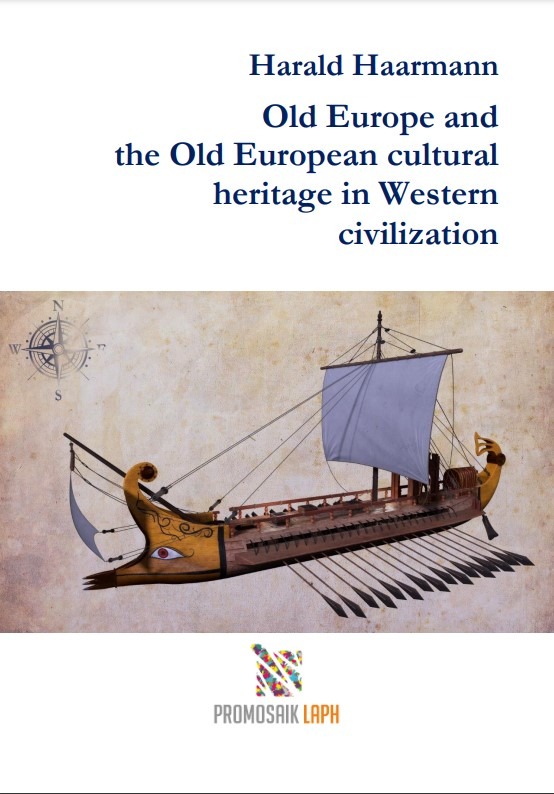
Dr. Harald Haarmann is a linguist, cultural scientist and philosopher. Since 2003 he has been Vice-President of the Institute of Archaeomythology and director of its “European Branch”. He has authored more than 80 books.
Some of them have been translated into over a dozen languages, including Spanish, Italian, French, Hungarian, Romanian, Bulgarian, Chinese, Japanese, and Korean. Among his works are several world histories of writing, languages, numbers, ancient civilizations, and forgotten cultures. The scope of the present volume is to draw attention to a world of major achievements, in the social, cultural and technological domains, that served as a corner-stone for the layout of Greek civilization. Greek antiquity developed into a sort of turntable for these achievements experiencing manifold transformations and then transferred to the emerging Western civilizations.
The presentation by the author:
It is the great merit of Marija Gimbutas (1921-1994) to have highlighted the contours of the Old European advanced society, conceived as a blanket term overarching several regional cultures in southeastern Europe — Vinča, Turdaş and Tărtăria, Karanovo, Cucuteni, Gumelnița, Trypillya — their egalitarian economic and communal life. She inspired imagination with the descriptions of a worldview focusing on a female divinity, with expressions in art, a complex system of signs and symbols and early technological achievements. Moreover, she outlined Old European influence into all directions. Marija Gimbutas elaborated a thorough documentation of how the traditions of these peacefully prospering societies were overformed with hierarchy and patriarchy by immigrating Indo-Europeans from the steppe. This eminent scholar’s discovery is an essential ingredient in humankind’s history and her insights are of an exceptional magnitude for the humanities.
The findings of Marija Gimbutas have enriched and invigorated studies and scientific exchange among the different disciplines — archaeology, ancient history, linguistics, sociology, comparative religion. In a way, building on the legacy of Marija Gimbutas became a mission. The great panorama of ancient Europe and its structure gained in profile.
For a long time Marija Gimbutas’s fieldwork on Old Europe as an ancient civilization was debated. Findings have been doubted and discredited. Unjustly, so. The results of subsequent research confirmed her work and today there is consensus among experts that Old Europe is the so far oldest known advanced culture of humankind.
Nevertheless, those who are still following their accustomed canon of traditional civilization research continue to associate Mesopotamia with the notion of ex oriente lux (“light from the East”) and consider the Middle East to be the “cradle of civilization”. At the time when Marija Gimbutas was conducting her research, this view was quite understandable, since many results of their research had not yet been confirmed by additional studies. Findings from interdisciplinary research that lead to the revision of data previously considered secure are continuously reconfirmed in recent studies, and new insights call for a significant revision not only of historiography but for various scientific fields of the humanities.
Ever new discoveries are adding to the validity of Old Europe as advocated by Marija Gimbutas, and the documentation and dating of material evidence have been secured with new dating methods. Thus, the chronological sequence of the Old European cultural horizon has been mapped out and its validity reconfirmed. High time to correct outdated knowledge, to disseminate the valid findings about the first advanced civilization of mankind, its marks in subsequent cultures with influence up to the present, in words and images and, eventually bringing about a corrective of the related historiography.
Just to illustrate the foregoing: According to the canon of ex oriente lux Mesopotamia and its early Sumerian civilization were credited for the development of early urbanized settlements and of urban life-ways, for the introduction of the plough and the potter’s wheel, for the early smelting of metal, for the first use of writing numbers and writing language. Mesopotamia is also credited for the invention of wheel and wagon. But none of these innovations originated in Mesopotamia.
All this and a series of impressive developments originated in Old Europe:
– The world’s first use of the plough;
— The world’s first egalitarian society under the auspices of a high culture.
— The world’s first urban agglomerations (the megasettlements of the Copper Age in Old Europe emerged hundreds of years earlier than the first Sumerian cities of Mesopotamia);
– The world’s first wide trading network, stretching for thousands of kilometers and connecting hundreds of settlements (river trade, sea-borne trade);
– The world’s first two-storey buildings and condominiums;
– The world’s first sign system for writing numbers;
– The world’s first writing;
– The invention of the potter’s wheel (first documented for the area of the eastern Cucuteni-Trypillya culture);
– The invention of the two-storey furnace with an upper chamber for burning ceramic ware and a lower chamber for heating;
– The smelting of copper (beginnings around 5400 BCE in southern Serbia);
– The working of gold (the world’s oldest artifacts made of gold from Varna in Bulgaria, dating to c. 4500 BCE);
— The world’s first wheel technology as a breakthrough development in cooperation with Indo-European pastoralists on the eastern fringe of Old Europe, in the area of modern-day Moldova and western Ukraine. The timeframe for the advancement of wheel technology was the span between the end of the second out-migration (Kurgan II) around 3800 BCE and the beginning of the third out-migration (Kurgan III) around 3200 BCE.
The basic terminology of this technology is of Indo-European coinage while a more specialized set of technical terms is related to the non-Indo-European language of the ancient Europeans. Elements of this specialized terminology for wheel and wagon persisted, as lexical borrowings, in the vocabulary of ancient Greek (Haarmann 2022).
The Palaeolithic and Mesolithic Europeans had been hunter-gatherers until they found out the advantages of a sedentary life with herding small animals such as sheep and goats and farming. In the coastal region of southern Europe (in the historical landscape of Thessaly in nowadays Greece) this change developed amidst a milieu of sociocultural contacts with pioneer groups of Anatolian farmers as has been specified by gene analysis. The former hunter-gatherers experienced a process of acculturation, and the agrarian lifeway that spread inland into southeastern Europe proved itself useful and beneficial for a peaceful egalitarian coexistence around 6000 BCE. That was the background for the emergence of Old Europe as the earliest model of a commonwealth in human history.
To purchase a copy of the book, click here

